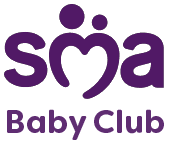Introduction
There’s no better start you can give your baby than breastfeeding and with a bit of practice, you should soon settle into the routine that works best for both of you.
There’s lots of support out there: your local breastfeeding support group, healthcare professionals - doctor, midwife, health visitor - or friends and family. And the SMA Careline® team are on hand to help too.
How to breastfeed
-
Wash your hands before you start and have a glass of water close by - breastfeeding can be thirsty work. Get yourself comfortable by sitting down with your back straight and your lap flat. Pop a couple of cushions behind you to support your back. Use another cushion on your knees to help bring baby closer to your breast if needed.
-
Find the right breastfeeding position. Lay baby across your lap supporting their head, shoulders and body in a straight line. Position their nose opposite your nipple and allow their head to tilt back, supporting it with one hand. Use the other to hold them on their side.
-
Line up baby's nose with your nipple. Their mouth should open wide, enough to cover the nipple and the lower part of the dark areola. If it doesn’t, brush your nipple across their top lip to encourage them.
-
Make sure your baby has a good breastfeeding latch. They will tilt their head back and their chin will be touching your breast. They should take a large mouthful of breast and your nipple should go towards the roof of their mouth. You may need to support your breast and make sure it doesn’t obstruct baby’s breathing.
-
Check for swallowing. When your milk begins to flow (known as the let-down reflex), you'll hear your baby swallowing and see their jaw moving. As your flow increases, you may feel some tingly sensations in your breast — this is quite normal.
-
Feed on demand. To satisfy their hunger and thirst, let your baby feed for as long and as often as they want. The more your baby drinks, the more milk your breasts produce. If your baby still wants more milk, offer the other breast. When they’ve had enough, your baby will let go of your breast or fall asleep. You can learn more your baby’s full up cue’s in our responsive feeding section.
-
Babies love breast milk, and as well as swallowing all that goodness, they may swallow some air. Winding them helps bring this air up so the milk goes down and helps prevent painful trapped wind. The best time for burping your baby is in the middle of a feed or just after. Read more advice in our guide to burping a baby.
-
Of course, no two babies will feed the same way. More than 50% of all babies experience some kind of baby feeding issue in their first year. Take a look at our feeding symptoms checker to learn more about colic, constipation & reflux. If you are concerned with any issues with feeding speak to your midwife, health visitor, public health nurse or GP.
Different breastfeeding positions
Besides the cradle hold position described above, there are other breastfeeding positions you may wish to try:

The under arm or rugby hold position
With their head to your breast, tuck baby’s body and legs behind you through the crook of your arm. Make sure they are lying on their back, with their nose to your nipple. Use your arm and hand to support baby and use the other hand to move your breast to their mouth.

Breastfeeding lying down
Lie on your side in the centre of your bed and lay baby on their side facing you. Use your hand on their back to gently support them, keeping them close. Be careful not to fall asleep whilst using this position.
Burping your baby after breastfeeding
At the end of each feed (and sometimes midway through), you’ll want to burp, or wind, your baby for a few minutes to help relieve any trapped air in their tummies. If you’re not sure where to start, you can read all about how to burp a newborn.
Newborn tummy troubles
So, you’ve read our ‘How to breastfeed’ list and tried all the different breastfeeding positions and you’re still having problems feeding. Don’t worry, your baby may be suffering from one of the more common tummy problems. To get to the bottom of it (quite literally, perhaps) you can read all about diarrhoea, colic and constipation. If you are concerned with any issues with feeding speak to your midwife, health visitor, public health nurse or GP.
Expressing breast milk
Breast milk is the best super food for babies and it’s one of the most wonderful things you can give them. Having the option to express breast milk can be a huge help when you can’t be there to breastfeed baby yourself. You might be apart from baby due to work, a partner might want to help with feeding, or maybe you just want a night out with friends. Make sure to only start expressing breast milk after 6 weeks to make sure breastfeeding is fully established.
Premature babies
If your baby is born prematurely, you may want to try expressing breast milk, since they might be too small or unwell to feed straight from the breast. The Neonatal ward team will be able to help you.
Breast milk is the best option since it’s easier to digest and full of nutrients and hormones to promote growth, it also helps protect your baby from certain infections and provides other health benefits. Find out more on the different ways to feed a preterm baby.














